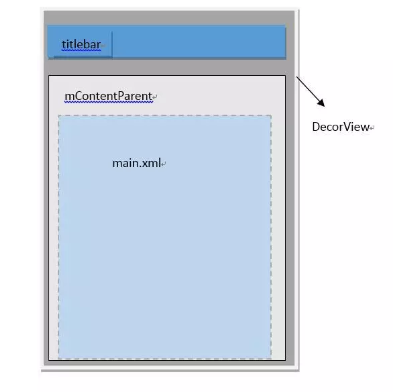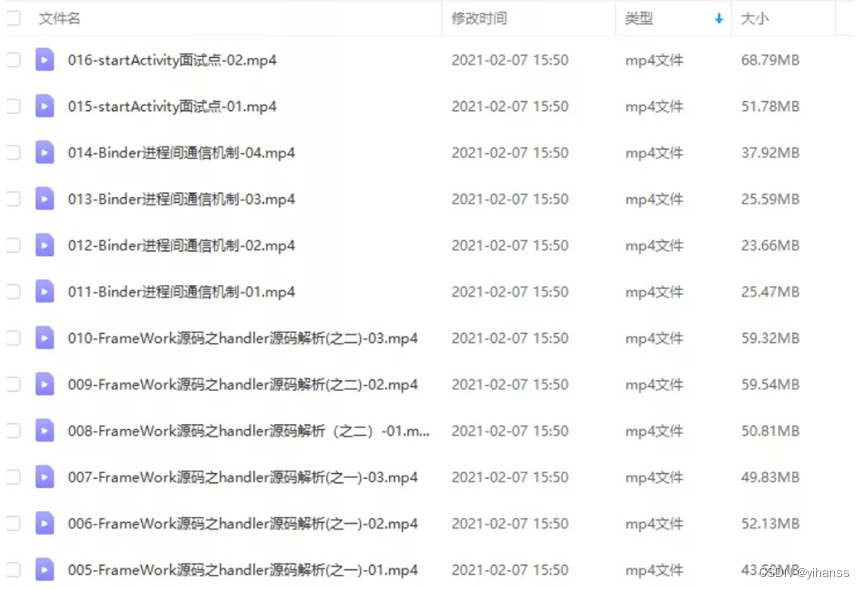一、从setContentView说起
一般的,我们会在Activity的onCreate()方法中写下这一行代码:
setContentView(R.layout.main);
显然这是为Activity设置的一个我们定义好的main.xml布局,我们跟踪一下源码,看看这个方法是怎么做的:
public void setContentView(@LayoutRes int layoutResID) {
getWindow().setContentView(layoutResID); //调用getWindow方法,返回mWindow
initWindowDecorActionBar();
}
...
public Window getWindow() {
return mWindow;
}
可以看出,里面调用了mWindow的setContentView方法,那么这个"mWindow"是什么?再追踪,发现mWindow是Window类型的,但他是一个抽象类,setContentView也是抽象方法,所以我们要找到Window的实现类。发现在Activit的attach方法中:
final void attach(Context context, ActivityThread aThread,
Instrumentation instr, IBinder token, int ident,
Application application, Intent intent, ActivityInfo info,
CharSequence title, Activity parent, String id,
NonConfigurationInstances lastNonConfigurationInstances,
Configuration config, String referrer, IVoiceInteractor voiceInteractor) {
...
mWindow = new PhoneWindow(this);
...
}
由此可见,PhoneWindow是Window的实现类,那么我们在PhoneWindow中找他的setContentView方法:
@Override
public void setContentView(int layoutResID) {
// Note: FEATURE_CONTENT_TRANSITIONS may be set in the process of installing the window
// decor, when theme attributes and the like are crystalized. Do not check the feature
// before this happens.
if (mContentParent == null) { // 1
installDecor();
} else if (!hasFeature(FEATURE_CONTENT_TRANSITIONS)) {
mContentParent.removeAllViews();
}
if (hasFeature(FEATURE_CONTENT_TRANSITIONS)) {
final Scene newScene = Scene.getSceneForLayout(mContentParent, layoutResID,
getContext());
transitionTo(newScene);
} else {
mLayoutInflater.inflate(layoutResID, mContentParent); // 2
}
final Callback cb = getCallback();
if (cb != null && !isDestroyed()) {
cb.onContentChanged();
}
}
首先判断了mContentParent是否为null,如果为空则执行installDecor()方法,那么这个mContentParent又是什么呢?
// This is the view in which the window contents are placed. It is either
// mDecor itself, or a child of mDecor where the contents go.
private ViewGroup mContentParent;
他是一个ViewGroup类型,结合2处代码,这个mContentParent使我们设置的布局(即main.xml)的父布局。注释还提到,这个mContentParent是mDecor本身或者是mDecor的一个子元素,这句话后面作解释
梳理一下:
Activity通过PhoneWindow的setContentView方法来设置布局,而设置布局前,会先判断是否存在mContentParent,而我们设置的布局文件则是mContentParent的子元素。
二、创建DecorView
当1中mContentParent为空时,则会执行installDecor()方法,我们看看源码
private void installDecor() {
if (mDecor == null) {
mDecor = generateDecor(); // 1
mDecor.setDescendantFocusability(ViewGroup.FOCUS_AFTER_DESCENDANTS);
mDecor.setIsRootNamespace(true);
if (!mInvalidatePanelMenuPosted && mInvalidatePanelMenuFeatures != 0) {
mDecor.postOnAnimation(mInvalidatePanelMenuRunnable);
}
}
if (mContentParent == null) {
mContentParent = generateLayout(mDecor); // 2
...
}
}
}
首先会执行1处代码,调用PhoneWindow.generateDecor方法
protected DecorView gengrateDecor(){
return new DecorView(getContext(),-1);
}
可以看出,这里实例化了DecorView,而DecorView则是PhoneWindow类的一个内部类,继承于FrameLayout,由此可知它也是一个ViewGroup
那么,DecorView到底充当了什么样的角色呢?
其实,DecorView是整个ViewTree的最顶层View,它是一个FrameLayout布局,代表了整个应用的界面。在该布局下面,有标题view和内容view两个子元素,而内容view则是上面提到的mContentParent。我们接着看2处代码,看PhoneWindow.genrateLayout方法
protected ViewGroup generateLayout(DecorView decor) {
// Apply data from current theme.
// 从主题文件中获取样式信息
TypedArray a = getWindowStyle();
...
if (a.getBoolean(R.styleable.Window_windowNoTitle, false)) {
requestFeature(FEATURE_NO_TITLE);
} else if (a.getBoolean(R.styleable.Window_windowActionBar, false)) {
// Don't allow an action bar if there is no title.
requestFeature(FEATURE_ACTION_BAR);
}
if(...){
...
}
// Inflate the window decor.
// 加载窗口布局
int layoutResource;
int features = getLocalFeatures();
// System.out.println("Features: 0x" + Integer.toHexString(features));
if ((features & (1 << FEATURE_SWIPE_TO_DISMISS)) != 0) {
layoutResource = R.layout.screen_swipe_dismiss;
} else if(...){
...
}
View in = mLayoutInflater.inflate(layoutResource, null); //加载layoutResource
decor.addView(in, new ViewGroup.LayoutParams(MATCH_PARENT, MATCH_PARENT)); //往DecorView中添加子View,即mContentParent
mContentRoot = (ViewGroup) in;
ViewGroup contentParent = (ViewGroup)findViewById(ID_ANDROID_CONTENT); // 这里获取的就是mContentParent
if (contentParent == null) {
throw new RuntimeException("Window couldn't find content container view");
}
if ((features & (1 << FEATURE_INDETERMINATE_PROGRESS)) != 0) {
ProgressBar progress = getCircularProgressBar(false);
if (progress != null) {
progress.setIndeterminate(true);
}
}
if ((features & (1 << FEATURE_SWIPE_TO_DISMISS)) != 0) {
registerSwipeCallbacks();
}
// Remaining setup -- of background and title -- that only applies
// to top-level windows.
...
return contentParent;
}
首先,根据设置主题样式来设置DecorView的风格,比如说有没有titlebar,接着为DecorView添加子View,而这里的子View是上面提到的mContentParent,如果上面设置了FEATURE_NO_ACTIONBAR,那么DecorView就只有mContentParent一个子View,这也解释了上面的疑问:这个mContentParent是mDecor本身或者是mDecor的一个子元素,用一幅图来表示:
在DecorView创建完毕后,让我们回到PhoneWindow.setContentView方法,直接看(一)中2处代码: mLayoutInflater.inflate(layoutResID, mContentParent);这里加载了我们设置的main.xml布局文件,并且设置mContentParent为main.xml的父布局,至于它怎么加载的,这里就不展开来说了。
到目前为止,通过setContentView方法,创建了DecorView和加载了我们提供的布局,但是这时,我们的View还是不可见的,因为我们仅仅是加载了布局,并没有对View进行任何的测量、布局、绘制工作。在View进行测量流程之前,还要进行一个步骤,那就是把DecorView添加至window中,然后经过一系列过程触发ViewRootImpl#performTraversals方法,在该方法内部会正式开始测量、布局、绘制这三大流程。至于该一系列过程是怎样的,因为涉及到了很多机制,这里简单说明一下:
三、将DecorView添加至Window
每一个Activity组件都有一个关联的Window对象,用来描述一个应用程序窗口。每一个应用程序窗口内部又包含一个View对象,用来描述应用程序窗口的视图。上文分析了创建DecorView的过程,接下来需要把DecorView添加到Window对象中。要了解这个过程,我们先要了解Activity的创建过程
首先,在ActivityThread.handleLaunchActivity中启动Activity,这里会调用Actitivy.onCreate()方法,从而完成上面的DecorView创建动作,当onCreate()方法执行完毕,在handleLaunchActivity方法会继续调用ActivityThread.handleResumeActivity方法:
final void handleResumeActivity(IBinder token, boolean clearHide, boolean isForward) {
//...
ActivityClientRecord r = performResumeActivity(token, clearHide); // 这里会调用到onResume()方法
if (r != null) {
final Activity a = r.activity;
//...
if (r.window == null && !a.mFinished && willBeVisible) {
r.window = r.activity.getWindow(); // 获得window对象
View decor = r.window.getDecorView(); // 获得DecorView对象
decor.setVisibility(View.INVISIBLE);
ViewManager wm = a.getWindowManager(); // 获得windowManager对象
WindowManager.LayoutParams l = r.window.getAttributes();
a.mDecor = decor;
l.type = WindowManager.LayoutParams.TYPE_BASE_APPLICATION;
l.softInputMode |= forwardBit;
if (a.mVisibleFromClient) {
a.mWindowAdded = true;
wm.addView(decor, l); // 调用addView方法
}
//...
}
}
}
在该方法内部,获取该Activity所关联的window对象,DecorView对象,以及windowManager对象,而windowManager对象是抽象类,它实现类为windowManagerImpl,所以后面调用的事windowManagerImpl.addView方法:
public final class WindowManagerImpl implements WindowManager {
private final WindowManagerGlobal mGlobal = WindowManagerGlobal.getInstance();
...
@Override
public void addView(View view, ViewGroup.LayoutParams params) {
mGlobal.addView(view, params, mDisplay, mParentWindow);
}
}
调用了mGlobal的成员函数,而mGlobal则是windowManagerGlobal的一个实例,那么我们看看WindoManagerGlobal.addView方法:
public void addView(View view, ViewGroup.LayoutParams params,
Display display, Window parentWindow) {
...
ViewRootImpl root;
View panelParentView = null;
synchronized (mLock) {
...
//实例化了ViewRootImpl类
root = new ViewRootImpl(view.getContext(), display);
view.setLayoutParams(wparams);
mViews.add(view);
mRoots.add(root);
mParams.add(wparams);
}
// do this last because it fires off messages to start doing things
try {
//调用ViewRootImpl.setView方法,把DecorView作为参数传递进去
root.setView(view, wparams, panelParentView);
} catch (RuntimeException e) {
// BadTokenException or InvalidDisplayException, clean up.
synchronized (mLock) {
final int index = findViewLocked(view, false);
if (index >= 0) {
removeViewLocked(index, true);
}
}
throw e;
}
}
在方法内部,会通过跨进程方式向WMS(WindowManagerService)发起一个调用,从而将DecorView最终加到Window上,在这个过程中,ViewRootImpl、DecorView和WMS会彼此关联。
最后,WMS调用ViewRootImpl.perforTraverals方法开始View的测量、布局、绘制。
来自:https://www.yuque.com/yutao-pdqwk/pt44ra/ft49h4#QdP67
最后
如果想要成为架构师或想突破20~30K薪资范畴,那就不要局限在编码,业务,要会选型、扩展,提升编程思维。此外,良好的职业规划也很重要,学习的习惯很重要,但是最重要的还是要能持之以恒,任何不能坚持落实的计划都是空谈。
如果你没有方向,这里给大家分享一套由阿里高级架构师编写的《Android八大模块进阶笔记》,帮大家将杂乱、零散、碎片化的知识进行体系化的整理,让大家系统而高效地掌握Android开发的各个知识点。

相对于我们平时看的碎片化内容,这份笔记的知识点更系统化,更容易理解和记忆,是严格按照知识体系编排的。
全套视频资料:
一、面试合集

二、源码解析合集

三、开源框架合集

欢迎大家一键三连支持,若需要文中资料,直接点击文末CSDN官方认证微信卡片免费领取

























 792
792











 被折叠的 条评论
为什么被折叠?
被折叠的 条评论
为什么被折叠?








